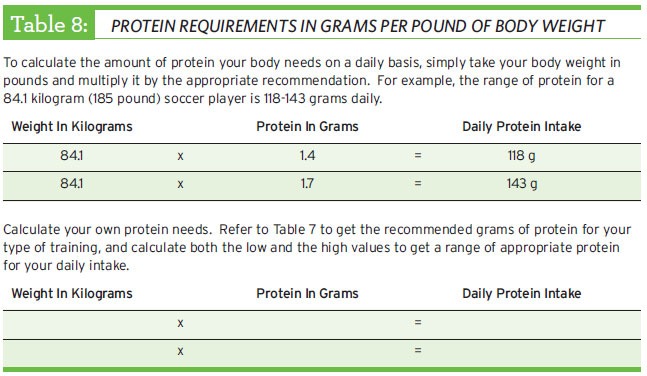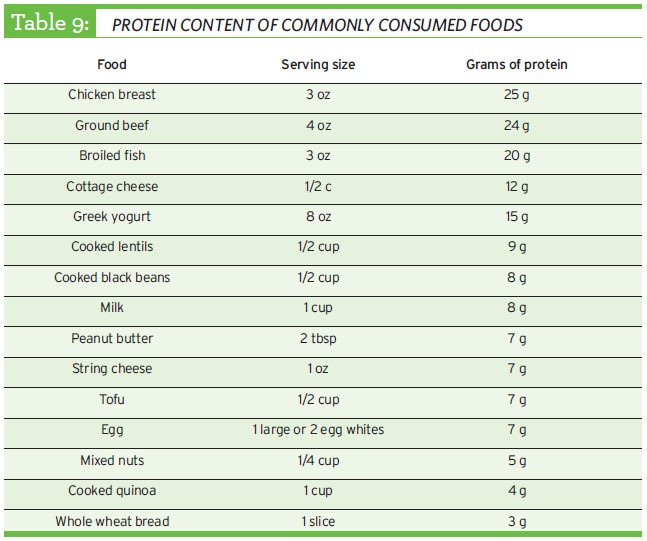Protein's role as a team player
Protein has always been a particularly popular nutrient with athletes because of its role in building and maintaining muscles. Indeed, athletes need to consume a wide variety of high-quality protein foods in their diets. However, while protein is necessary for rebuilding and repairing muscles, it is not the primary fuel, and consuming more protein than what the body can use is not going to give athletes larger and stronger muscles. While research shows that protein requirements are higher for athletes to aid in muscle repair and growth, most athletes are already consuming more protein than the body can use. Use the following formulas as guidelines to ensure proper amounts of protein are included in your dietary intake.

TABLE 7 IMAGE TEXT:
DAILY PROTEIN RECOMMENDATIONS
Type of Training
- Endurance
- Strength (to gain muscle mass)
- Strength (maintenance)
- Weight Restricted
Grams (g) of Protein Recommended
- 1.2-1.4 g of protein per kilogram of body weight
- 1.6-2.0 g of protein per kilogram of body weight
- 1.6-1.7 g of protein per kilogram of body weight
- 1.8-2.0 g of protein per kilogram of body weight

TABLE 8 IMAGE TEXT:
PROTEIN REQUIREMENTS IN GRAMS PER POUND OF BODY WEIGHT
To calculate the amount of protein your body needs on a daily basis, simply take your body weight in rounds and multiply it by the appropriate recommendation. For example, the range of protein for a 84.1 kilogram (185 pound) soccer player is 118-143 grams daily.
84.1 (kilograms of weight) x 1.4 (grams of protein) = 118 g (daily protein intake).
Calculate your own protein needs. Refer to Table 7 to get the recommended grams of protein for your type of training, and calculate both the low and the high values to get a range of appropriate protein for your daily intake.

TABLE 9 IMAGE TEXT:
PROTEIN CONTENT OF COMMONLY CONSUMED FOODS
Food
- Chicken breast
- Ground beef
- Broiled fish
- Cottage cheese
- Greek yogurt
- Cooked lentils
- Cooked black beans
- Milk
- Peanut butter
- String cheese
- Tofu
- Egg
- Mixed nuts
- Cooked quinoa
- Whole wheat bread
Serving size
- 3 oz
- 4 oz
- 3 oz
- 1/2 cup
- 8 oz
- 1/2 cup
- 1/2 cup
- 1 cup
- 2 tbsp
- 1 oz
- 1/2 cup
- 1 large or 2 egg whites
- 1/4 cup
- 1 cup
- 1 slice
Grams of protein
- 25 g
- 24 g
- 20 g
- 12 g
- 15 g
- 9 g
- 8 g
- 8 g
- 7 g
- 7 g
- 7 g
- 7 g
- 5 g
- 4 g
- 3 g
Building Body Mass
Many athletes want to add more bulk to their bodies in the form of lean muscle. Many supplement products claim to build muscles. Athletes should take special caution when considering supplementation (please see the Supplements and Your Health section for additional information and cautions). Due to the limited regulations of the dietary supplement industry, there is a risk of products being contaminated with sport-prohibited or unknown substances with or without the manufacturer knowing. There is no guarantee that the product contents match with those listed on the label. Taking a lot of extra protein either from supplements or food does not guarantee bigger muscles. If it did, athletes could spend time lounging instead of lifting to build muscle.
The following are healthy ways to build muscle:
- Follow a strength training program that challenges muscles.
- Add 500 to 1,000 more calories each day to current dietary intake, to allow the body to use protein already present in the diet for muscle growth and not be broken down to fuel activity.
- Eat foods that are both high in carbohydrates and proteins like grilled chicken sandwiches, peanut butter sandwiches, and Greek yogurt with granola.
- Choose low-fat sources of both carbohydrates and protein.
- Eat several small meals that include about 30 grams of protein or about 0.3 grams of protein/kilogram throughout the day, which will support training and muscle-building.
- Choose lean animal sources of protein (i.e. dairy and meats) which are more efficiently absorbed by the body.
Protein After Exercise
The body’s ability to recover from games, practices, or intense workouts requires adequate rest and proper nutrition. An important component of the recovery process is consuming both carbohydrates and protein shortly after exercise to restore muscle glycogen and stimulate muscle protein synthesis.
EAT
Keep in mind that food is fuel and athletes should not come to practice or games without having had enough food to support the energy requirements for their sport. To keep athletes properly fueled and have protein needs met, use the E.A.T. guidelines:
- Eat breakfast. It is the best way to start the day well fueled. Include foods that contain carbohydrates and protein such as nonfat milk, yogurt, or eggs.
- Add carbohydrates and protein to post-exercise meals. Some energy bars provide carbohydrates to replenish muscle glycogen stores and protein to help build and repair muscles.
- Toss the supplements. Athletes should rely on protein from food sources first, instead of supplements. This helps ensure that diets are balanced for health and performance. In addition to meat sources of protein, dairy products, nuts, and seeds are all rich sources of protein and can easily be added to any meal or snack.
Read the full Nutrition Guide and learn more about how to get peak performance with optimal nutrition.


